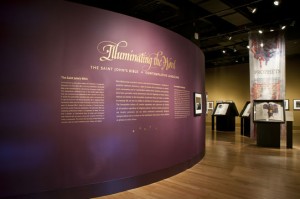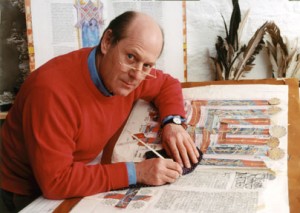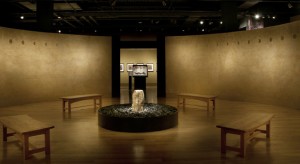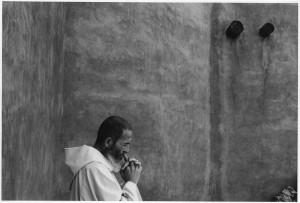 On Monday, Dec. 31, 2012, museum staffers will begin tearing down Illuminating the Word: The Saint John’s Bible and Contemplative Landscape. Housed together in the museum’s second-floor Herzstein Gallery, the exhibits speak not only of art, of the history of the printed word, and of the role that spirituality plays in our state, but they also speak to a place uniquely special within each of us.
On Monday, Dec. 31, 2012, museum staffers will begin tearing down Illuminating the Word: The Saint John’s Bible and Contemplative Landscape. Housed together in the museum’s second-floor Herzstein Gallery, the exhibits speak not only of art, of the history of the printed word, and of the role that spirituality plays in our state, but they also speak to a place uniquely special within each of us.
A hallmark of the exhibit has been a golden-hued meditation space nestled within its center. As we headed into the Christmas holiday, we decided to hold a small ceremony in that space to honor the exhibit with our thoughts about what it meant to us and how we saw it change others.
Tom Leech, who curated The Saint John’s Bible portion in concert with Saint John’s University and Abbey in Collegeville, Minn., kicked it off.
“We pulled off something great, something above and beyond what we were expecting,” he said. “Fran (Levine, the museum’s director) keeps talking about teamwork, but this proves that it really happens. At times it felt like pulling teeth, but we sailed through a lot of heavy stuff.”
 Here’s the thing: Several years ago, Tom fell in love with the Saint John’s project — the first calligraphed and illuminated Bible commissioned by Benedictine monks in something like 500 years. Donald Jackson (at left), Queen Elizabeth’s calligrapher, conceived the project while on an artists’ retreat at Ghost Ranch in New Mexico, then oversaw it from his scriptorium in Wales. The Ghost Ranch piece that kicked off years of fund-raising, hand-writing, and the final “Amen” last year, was displayed for the first time in our museum’s version of the exhibit, which has appeared in other cities.
Here’s the thing: Several years ago, Tom fell in love with the Saint John’s project — the first calligraphed and illuminated Bible commissioned by Benedictine monks in something like 500 years. Donald Jackson (at left), Queen Elizabeth’s calligrapher, conceived the project while on an artists’ retreat at Ghost Ranch in New Mexico, then oversaw it from his scriptorium in Wales. The Ghost Ranch piece that kicked off years of fund-raising, hand-writing, and the final “Amen” last year, was displayed for the first time in our museum’s version of the exhibit, which has appeared in other cities.
Pairing our 44 pages with photographs of sacred places — from Tony O’Brien’s work at Christ in the Desert Monastery, historical images from the Palace of the Governors Photo Archives, and interpretations by contemporary shooters — initially sounded like an odd shoe-horning. But in meeting upon meeting, we brought our ideas out, sanded here, excised there, and together built an exhibit so eloquent that Saint John’s Abbey extended its run in Santa Fe and is borrowing elements of it for future exhibits in other cities.
“I’ve had so many people say, `Whose idea was this to bring these exhibits together?'” Fran said. “And I say, `Our team.’ It was an iterative process. It was building this — this meditation room (I really hate to see this go). It comes from that respect we have for each other as museum people. I suppose we could get to the place where we say, `No, the walls have to be white and you can never put a nail in the floor,’ but that’s not what we do.”
“It’s a community and it’s how it is molded by us together,” said Caroline Lajoie, the exhibition designer. “We catch ideas from one time or another, and we all came to a place where it makes sense. My daughter, who was in my belly when I was designing exhibits years ago, she is a fanatic of this. It’s her completely favorite exhibit. She cares very little for the work I’ve done, but she goes straight to the pages whenever she’s here.”
 Even the meditation space was an idea in need of evolution. Originally, we dreamed of building a labyrinth in the space and inviting visitors to walk it slowly. As the design for it became complicated with questions that included how more than one person could walk it at a time without bumping shoulders, we decided to create a simple spiral — and even researched some lovely information about the way spirals appear in all of nature. Finally, we stripped it down to bare essentials: curved walls, four benches, and phases of the moon on high.
Even the meditation space was an idea in need of evolution. Originally, we dreamed of building a labyrinth in the space and inviting visitors to walk it slowly. As the design for it became complicated with questions that included how more than one person could walk it at a time without bumping shoulders, we decided to create a simple spiral — and even researched some lovely information about the way spirals appear in all of nature. Finally, we stripped it down to bare essentials: curved walls, four benches, and phases of the moon on high.
Surrounding the meditation space are the cases holding the Bible pages and surrounding them are the photographs. Outside the exhibition, in the museum’s Gathering Space, we grouped couches around a television showing documentaries about The Saint John’s Bible and Christ in the Desert Monastery. On occasional weekends, local calligraphers demonstrated their work in the space. A robust programming schedule included lectures by artists and photographers and several performances by Schola Cantorum and the monks of Christ in the Desert Monastery.
Larry Luck, one of our volunteer guides, became an expert on the project and has thus far conducted more than 60 tours of the exhibit. (He still has two to go.)
“I saw this exhibition in Phoenix several years ago,” he said. “It wasn’t as attractively presented and was kind of crowded. Here, when you’re looking at a page, your eyes go down, but the photographs make your eyes go up. What was interesting was the number of people who were repeat visitors and who would bring friends and then their friends would bring friends. I was so pleased when it was extended because that meant I could still use all the knowledge I’d gained.”
Those repeat customers were apparent to Mary Anne Redding, the museum’s former photo archivist who curated Contemplative Landscape. Now the director of the photography department at the Santa Fe University of Art and Design, she’s overheard students outside of her program talk about visiting the exhibit every week mainly to take advantage of the meditation space. At the space’s core is a slowly burbling fountain rising out of a glorious piece of granite that we weren’t quite sure what to do with after Dec. 31.
“I’m going to buy the fountain,” she said. “I have the place for it in my house, and it will keep the exhibit with me at home.”
 Tony attended our gathering and was visibly moved at how visibly moved we were. His photographs, which included this favorite image of a monk at prayer, are included in his book, Light in the Desert: Photographs from the Monastery of Christ in the Desert (Museum of New Mexico Press).
Tony attended our gathering and was visibly moved at how visibly moved we were. His photographs, which included this favorite image of a monk at prayer, are included in his book, Light in the Desert: Photographs from the Monastery of Christ in the Desert (Museum of New Mexico Press).
“As one of the artists involved, I want to thank you all,” he said. “I feel honored to be part of this exhibition. You’ve created a space that respected our work beyond words, and you’ve created a safe space. Every time I walk in here, things change. It all calms down. It’s inclusive of our community, our religions. When you’re in here, you’re allowed to be alone but you’re also part of a larger community. That is exceptional.”
One of the reasons we wanted to bring people together for this little gratitude ceremony was because of the wound we suffered as a nation last week from the shootings in Newtown, Conn. As we prepared to end the gathering and open the exhibition space to our visitors, we mutually and quietly agreed to a moment of silent prayer and reflection. It lasted longer than such moments usually do. We are, after all, so bruised and confused. But we were also, as participants in the exhibit, reluctant to say that this is it, this is the end, now we are leaving.
You have one more week. Please take advantage of these exhibits. Stand in awe, scrutinize the details, listen to the silence. They are our gifts to you.
